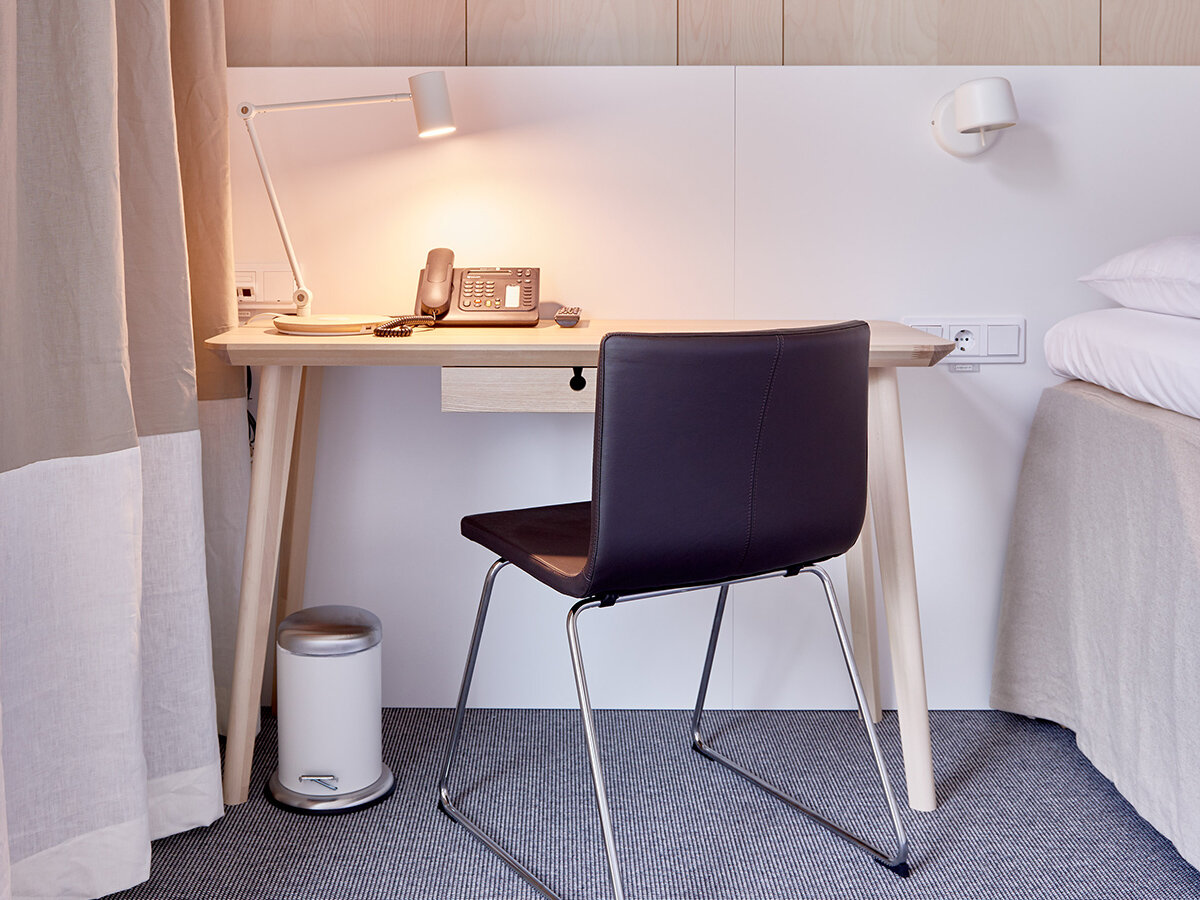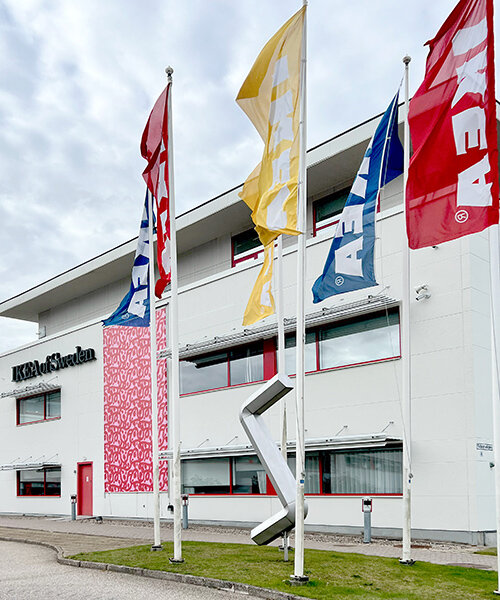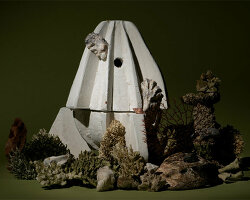decades of design, all starting in älmhult
Travelers who have taken the high-speed rail between Copenhagen and Stockholm know of the pastoral farming villages and endless woodlands which define southern Sweden. Many would be surprised to know that along that line hides a humble town with a big history. A Swedish village named Älmhult is home to a whole world of IKEA, and marks the starting point of both the store itself and nearly all IKEA furniture and objects produced to this day. Its story begins when the company’s founder, Ingvar Kamprad, opened the first-ever IKEA in 1958. Gradually, visitors began to flock to the once-quiet little town for entire day trips to explore the store. To help these day-trippers extend their stay, a unique hotel was built — the world’s only IKEA hotel. It was here that designboom had the privilege to stay to explore the heritage and future of the iconic Swedish company.
 IKEA of Sweden offices | image © designboom
IKEA of Sweden offices | image © designboom
a colorful heritage
During the decades following the opening of the IKEA store and hotel, there was a great expansion. The place flourished into a sprawling campus and destination. In 2016, after nearly sixty years, the store was moved to a neighboring location and an IKEA Museum took its place. While the original modernist building was designed by Swedish architect Claes Knutson, the museum conversion was led by UK-based WilkinsonEyre Architects.
The museum opened as a didactic celebration of the brand’s long history of iconic design. Currently on view is an exhibition titled IKEA Through the Ages — layered ‘rooms’ with vintage pieces typical of their time highlight the shifting styles in furniture design across eighty years through a Scandinavian lens. Of course IKEA’s designers today are fully embracing the austere and neutral Scandinavian style, but visitors will notice that the Swedes of the past were more interested in color and personal expression. For those keen on exploring these archival pieces but are not traveling to rural Sweden, IKEA has compiled an extensive digital archive of over seventy original catalogues dating back decades.
But the significance of Älmhult extends beyond its history — the town even hosts the headquarters where IKEA’s future takes shape. Every product seen in IKEA stores worldwide is developed here, underpinned by the company‘s long-held philosophy of Democratic Design.
 ‘IKEA Through the Ages,’ exhibition view, IKEA Museum Älmhult | image © IKEA
‘IKEA Through the Ages,’ exhibition view, IKEA Museum Älmhult | image © IKEA
the ‘complete sleep’ crafted by IKEA
At IKEA’s Älmhult headquarters, the design process unfolds with the precision expected of a company known for pieces that are at once functional, affordable, and built to last. Designers and engineers here look to the brand’s five Democratic Design principles: form, function, quality, sustainability, and a fair price. It’s a formula that has shaped IKEA’s success, as the team works to create products that are accessible to many and improve their daily life. Nowhere is this more evident than in IKEA’s latest campaign focused on one of life’s most essential, universal, and yet undervalued experiences — sleep.
In the sleepy Swedish town, IKEA designers from around the world are curating the concept of a ‘complete sleep.’ This serves as the backbone of IKEA’s new sleep range, which was developed through extensive research, product testing, and a deep understanding of what it means to sleep deeply. Of course, sleep is not just about the number of hours spent in bed, but the overall quality of that rest. With this in mind, the team hopes to draw attention to the often-neglected importance of sleep, arguing that good sleep is not a luxury but a necessity that enhances everyday life.
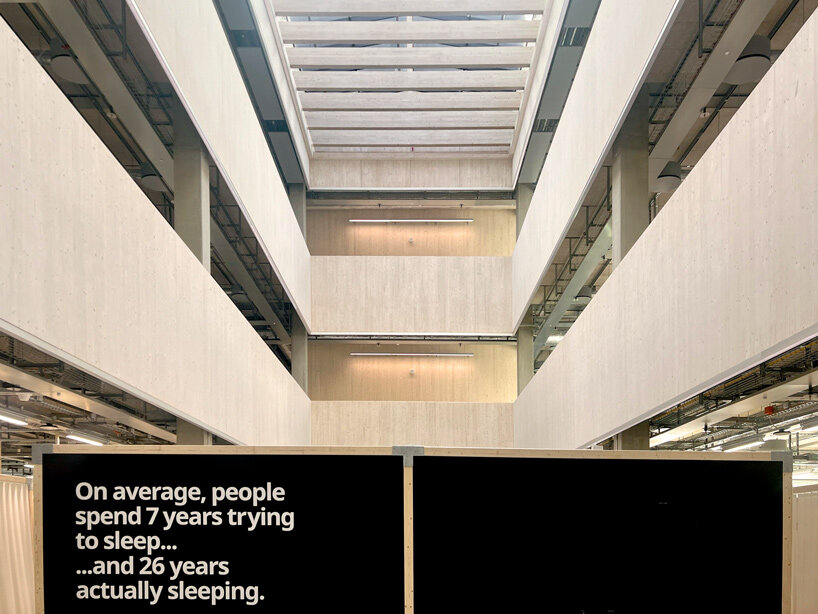
IKEA of Sweden offices, interior | image © designboom
a sleep-centric design approach
designboom met with the team at IKEA in Älmhult to learn for ourselves how the product designers and engineers approach such an ambitious task. The company’s focus on sleep is divided between six factors that influence sleep quality — comfort, temperature, light, sound, air quality, and declutter. These elements call for solutions like bedding, lighting, wardrobe systems, and air purifiers. Of course, at the core of this sleep-centric approach lies the mattress — a product that IKEA has spent decades perfecting.
Lena Julle, Acting Chief Sustainability Officer at Inter IKEA Group, tells designboom: ‘We spend so much time visiting people to find out how they live, what they like, and what they have problems with. Of course we back it up with research. The idea of Democratic Design is an integrated part of that. It is difficult to get all five elements right.
‘I’m surprised by how little information people have on what it takes to have a good sleep experience. We have a lot to share. Something that’s unique is that we have everything to make a good sleep under one roof, and it’s accessible and affordable. Everybody should be able to have a good sleep.’
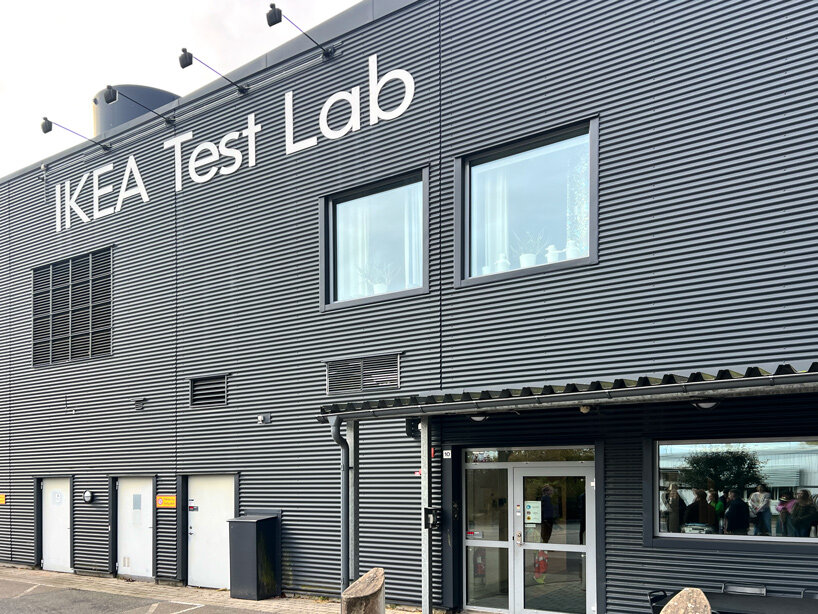 IKEA Test Lab | image © designboom
IKEA Test Lab | image © designboom
the ikea test lab
In the state-of-the-art IKEA Test Lab in Älmhult, mattresses undergo rigorous testing to meet the varied needs of diverse sleepers. Engineers explained the science behind developing different mattress prototypes, tailored for diverse body types, sleeping positions, and firmness preferences. The lab uses advanced machinery to simulate years of wear, detect pressure points of various body types, and measure the effect of sweating bodies. One machine applies to a mattress 1,400 newtons of weight, and painstakingly repeats 30,000 rolling motions to simulate the equivalent of ten years of use in just a few hours. This testing ensures that the mattresses bring the durability, comfort, and support essential for decades of deep rest.
 durability control demonstration at the IKEA Test Lab | image © IKEA
durability control demonstration at the IKEA Test Lab | image © IKEA
deep rest for everyone
Keeping in mind that everyone has unique sleeping preferences, IKEA’s approach is rooted in versatility. ‘Our goal is to fit as many different sleep needs as possible,’ explains Senior Product Design Engineer Tobias Franzen. Every mattress is designed with a range of preferences in mind, backed by rigorous testing that evaluates different body types and sleep positions. Whether spring-based or foam-based, each mattress is crafted to meet varying sleep styles. This precision extends beyond just mattresses, encompassing even mattress toppers, pillows, and bedding.
The team recognizes the highly individual nature of sleep, and works to ensure that its sleep range can be tailored to different priorities. ‘We all have different preferences for sleep,’ Franzen notes. By offering a mix of spring-based and foam-based mattresses, along with various comfort zones that support the body’s natural curves and pressure points, the range allows customers to personalize their sleep experience. With prototypes tested and developed to fit diverse needs, IKEA’s sleep solutions are designed to ensure that a deep sleep is accessible to everyone. IKEA has even created a digital comfort guide for anyone seeking a perfect fit.
 Johan Kroon (Product Design Developer), Tobias Franzen (Senior Product Design Engineer) demonstrating mattress range | image © IKEA
Johan Kroon (Product Design Developer), Tobias Franzen (Senior Product Design Engineer) demonstrating mattress range | image © IKEA
IKEA says: wake up! it’s time to sleep
IKEA’s vision has always been to create a better everyday life for the many, and sleep is one of the most fundamental elements of that mission. Creative Planner Edward Wilson explains: ‘Sleep is the one thing that literally helps every person on the planet to live that better everyday life. It’s a universal experience.’ While IKEA is known for its extensive sleep range, from mattresses to duvets and pillowcases to storage solutions, even convertible sleeper sofas, the brand approaches sleep from the perspective of real people with real limitations — those constrained by time, money, or space. ‘We know that for them, sleep isn’t about products. It’s about how they feel in the morning,’ he continues.
As sleep deprivation is commonly celebrated as a sign of hard work, IKEA is hoping to shift this mindset on a societal scale. Despite the fact that every animal with a brain sleeps, humans are unique in actively depriving themselves of it. As a society, we place little value on rest, wearing sleeplessness like a badge of honor. But good sleep is crucial — it makes us more productive, happier, and healthier, and it ultimately leads to longer lives. ‘That’s why we at IKEA are taking a stand against the idea that success only comes from sacrificing sleep. Good sleep needs to be something to look forward to. It needs to be a badge of honor over powering through tiredness.’

VÅGSTRANDA Mattress showing ‘comfort zones’ to support the body’s pressure points | image © IKEA
During the final leg of the visit, the team showed the complete sleep campaign in action, where product designers demonstrated how their minimalist and ultra-functional collections, such as the versatile Älskvärd baby furniture series, fit fluidly into IKEA’s sleep solutions. These products, like the bassinet and cot that transform across the different stages of childhood, are a physical expression of the company’s aims toward sustainability through adaptability, a key component of its Democratic Design philosophy.
After all, IKEA’s message is clear: sleep affects everything, from health to relationships and overall well-being. By focusing on ‘complete sleep,’ the company is helping to turn the act of resting into something more meaningful. And through its sleep range, IKEA is delivering thoughtfully-designed products that ensure better sleep is within everyone’s reach.

Sarah Fager (Senior Designer at IKEA of Sweden) walking through a typical design process | image © designboom





